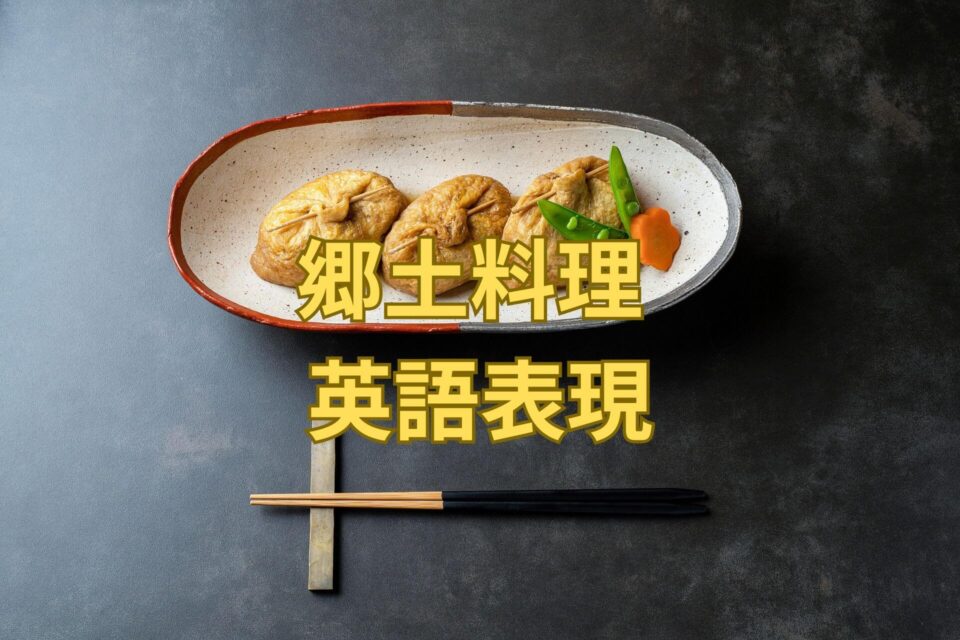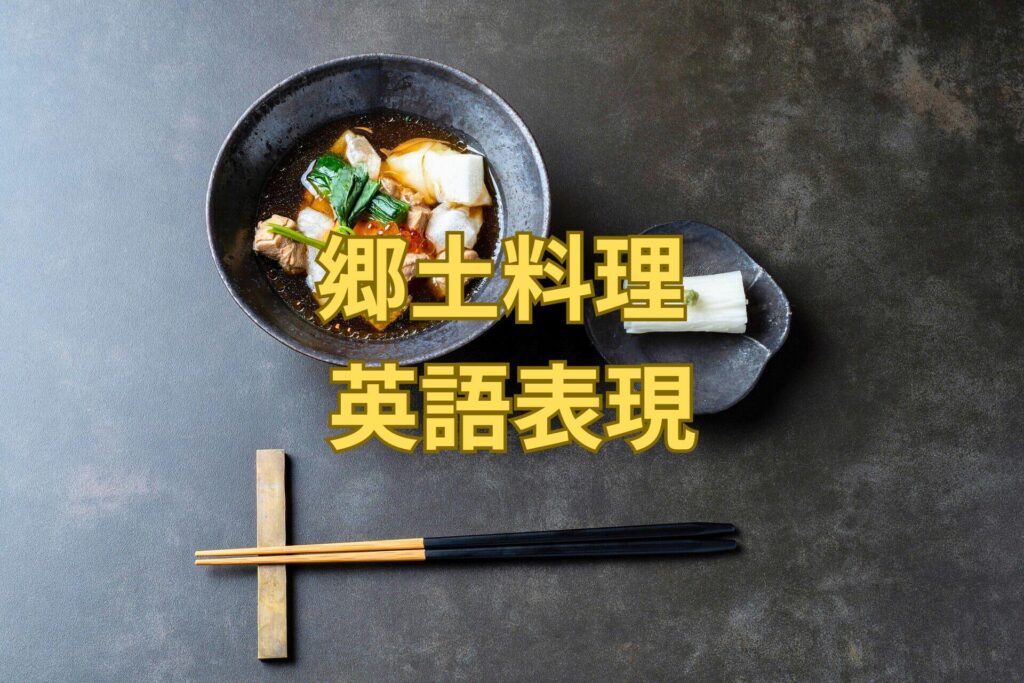郷土料理 英語表現8選! 例文 会話例で習得しましょう!
旅などで見知らぬ土地に行った時に、そこでしか味わえない郷土料理を楽しむのは良いものです。郷土料理を味わうことで、そこの地理や食材を学ぶことも出来ますね。
今回は「郷土料理 英語表現」をまとめてみました。
郷土料理 英語では?
郷土料理 英語表現
| 英語表現 | 日本語の意味 | ニュアンス・雰囲気 | 主な使用シーン |
|---|---|---|---|
| local cuisine | 地元料理・郷土料理 | 一番一般的で汎用的。「その土地の料理」全般を指す | 観光案内、旅行ガイド、カジュアル会話 |
| regional cuisine | 地方料理 | 「地域ごとの特色」を強調。国の中での違いを語る時に便利 | 書籍・学術的な文脈、旅行記事 |
| traditional cuisine | 伝統料理 | 「昔から続く料理」「伝統的な調理法」を強調 | 文化紹介、観光、レストランPR |
| native cuisine | 土着の料理 | その土地に根付いた料理というニュアンス。ややフォーマル | 文化研究、ドキュメンタリー、民族紹介 |
| indigenous cuisine | 先住民の料理 | 「先住民・原住民の食文化」を示す。文化人類学的で硬い響き | 学術・文化フェスティバル・観光資源紹介 |
| home-style cooking | 家庭料理・家庭風の郷土料理 | 素朴で温かいイメージ。お母さんの味・田舎料理に近い | 民宿、旅館、家庭的レストラン |
| specialty dish / local specialty | 名物料理 | 「その土地で特に有名な料理」「看板料理」 | 観光パンフ、レストランメニュー |
| heritage cuisine | 文化遺産的な料理 | 「文化財として守るべき伝統料理」という響き。やや専門的 | UNESCO 無形文化遺産、食文化保護、食の歴史 |
郷土料理 英語例文
1. local cuisine
We traveled to Kyoto to try the local cuisine.
(私たちは京都の郷土料理を味わうために旅行しました。)
Sampling the local cuisine is the best way to understand a culture.
(その土地の料理を試すのは文化を理解する最良の方法です。)
The guide recommended a restaurant famous for its local cuisine.
(ガイドは郷土料理で有名なレストランを勧めてくれました。)
2. regional cuisine
Hokkaido is well known for its regional cuisine, especially seafood dishes.
(北海道は郷土料理で有名で、特に海鮮料理が有名です。)
Regional cuisine varies greatly even within the same country.
(地方料理は同じ国の中でも大きく異なります。)
This book introduces the regional cuisine of southern Italy.
(この本は南イタリアの郷土料理を紹介しています。)
3. traditional cuisine
We enjoyed the traditional cuisine of Okinawa during our trip.
(旅行中に沖縄の伝統料理を楽しみました。)
Traditional cuisine is often passed down from generation to generation.
(伝統料理はしばしば代々受け継がれます。)
That restaurant serves traditional cuisine with a modern twist.
(そのレストランは伝統料理を現代風にアレンジして提供しています。)
4. native cuisine
Native cuisine reflects the history and environment of a region.
(土着の料理は地域の歴史や環境を反映しています。)
We were invited to a village to taste their native cuisine.
(私たちは村に招かれ、彼らの郷土料理を味わいました。)
Native cuisine often uses ingredients found only in that area.
(土着の料理はその地域にしかない食材を使うことが多いです。)
5. indigenous cuisine
Indigenous cuisine highlights the knowledge of local plants and animals.
(先住民の料理は地元の動植物の知識を示しています。)
The festival celebrates indigenous cuisine and traditional crafts.
(その祭りは先住民の料理と伝統工芸を祝います。)
Tourists are increasingly interested in indigenous cuisine for its uniqueness.
(観光客はその独自性から先住民の料理にますます関心を持っています。)
6. home-style cooking
I love visiting small inns because they serve home-style cooking.
(小さな旅館に泊まるのが好きなんだ、家庭風の郷土料理を出してくれるから。)
Home-style cooking reminds me of my grandmother’s dishes.
(家庭風の料理は祖母の作ってくれた料理を思い出させる。)
The restaurant specializes in home-style cooking from the countryside.
(そのレストランは田舎風の郷土料理を専門にしています。)
7. specialty dish / local specialty
Hiroshima’s local specialty is okonomiyaki.
(広島の名物料理はお好み焼きです。)
Every region has its own specialty dish.
(どの地域にもその土地ならではの名物料理があります。)
The local specialty of this town is a noodle soup made with river fish.
(この町の名物料理は川魚を使った麺料理です。)
8. heritage cuisine
Heritage cuisine preserves the flavors of the past.
(ヘリテージ料理は昔の味を守っています。)
The chef is dedicated to promoting heritage cuisine in modern dining.
(そのシェフはヘリテージ料理を現代の食事に広めることに尽力しています。)
Heritage cuisine is often recognized as part of cultural identity.
(ヘリテージ料理はしばしば文化的アイデンティティの一部と見なされます。)
郷土料理 英語会話例

1. local cuisine
A: I’m planning a trip to Japan and I really want to try the local cuisine.
B: That’s a great idea! Local cuisine is one of the best ways to understand a culture.
A: Do you have any recommendations?
B: Sure, in Kyoto, you should try yudofu and kaiseki dishes—they’re excellent examples of local cuisine.
A: Sounds delicious! I can’t wait to taste them.
B: Don’t forget to visit the markets too—they offer authentic local flavors.
和訳
A: 日本に旅行に行こうと思ってて、地元料理をぜひ味わいたいんだ。
B: いいね!地元料理は文化を理解する最良の方法のひとつだよ。
A: 何かおすすめはある?
B: もちろん。京都では湯豆腐や懐石料理を試してみて。地元料理の素晴らしい例だよ。
A: 美味しそう!早く食べてみたいな。
B: 市場にも行くのを忘れないで。本物の地元の味が楽しめるよ。
2. regional cuisine
A: I’m curious about regional cuisine in Japan.
B: Each region has its own specialties. For example, Hokkaido is known for seafood and dairy products.
A: Really? What about the Kansai region?
B: Kansai is famous for takoyaki and okonomiyaki. Regional cuisine can vary even within the same country.
A: That’s amazing! I want to try different dishes in each area.
B: It’s a delicious way to explore local culture.
和訳
A: 日本の地方料理に興味があるんだ。
B: 各地域には独自の名物料理があるよ。例えば北海道は海鮮や乳製品で有名だね。
A: 本当に?関西地方はどう?
B: 関西はたこ焼きやお好み焼きが有名だよ。同じ国の中でも地方料理は大きく違うんだ。
A: すごい!各地の料理を食べてみたいな。
B: 美味しくて文化も学べるいい方法だよ。
3. traditional cuisine
A: I want to experience traditional cuisine in Japan.
B: You should definitely try Okinawan dishes—they’re a great example of traditional cuisine.
A: What makes them traditional?
B: Traditional cuisine preserves recipes that have been passed down for generations, using local ingredients and cooking methods.
A: That sounds like a real cultural experience.
B: Exactly, and it’s often served in a way that reflects the local lifestyle.
和訳
A: 日本で伝統料理を体験したいな。
B: ぜひ沖縄料理を試してみて。伝統料理の素晴らしい例だよ。
A: 伝統的ってどういうこと?
B: 伝統料理は代々受け継がれたレシピを守り、地元の食材や調理法を使っているんだ。
A: それは本当に文化を体験できそうだね。
B: そうそう、地元の生活スタイルを反映した提供の仕方もされるんだよ。
4. native cuisine
A: I heard about native cuisine in small Japanese villages.
B: Yes, native cuisine reflects the local environment and ingredients that are unique to that village.
A: So it’s different from regional cuisine?
B: Exactly. While regional cuisine covers a larger area, native cuisine is specific to a community.
A: Can you give me an example?
B: In some mountain villages, they use local wild herbs and river fish—those are typical native cuisine dishes.
和訳
A: 日本の小さな村の土着料理って聞いたことある?
B: うん、土着料理はその村独自の環境や食材を反映しているんだ。
A: じゃあ地方料理とは違うの?
B: そうだね。地方料理は広い地域にわたるけど、土着料理は特定のコミュニティに限られるんだ。
A: 例を教えてくれる?
B: 山村では地元の野草や川魚を使うんだ。典型的な土着料理だよ。
5. indigenous cuisine
A: What’s the difference between native cuisine and indigenous cuisine?
B: Indigenous cuisine refers to the food of indigenous communities and highlights their traditional cooking methods.
A: So it’s more about culture than just location?
B: Exactly. It includes how they prepare and use ingredients that have been part of their culture for centuries.
A: That sounds fascinating. I’d love to try some.
B: You can often find indigenous cuisine at cultural festivals or local museums.
和訳
A: 土着料理と先住民の料理の違いは何?
B: 先住民の料理は先住民コミュニティの料理で、伝統的な調理法を強調しているんだ。
A: つまり場所よりも文化に関係しているの?
B: そう。何世紀もその文化で使われてきた食材や調理法が含まれているんだ。
A: 興味深いね。ぜひ試してみたいな。
B: 文化祭や地元の博物館で見つけられることが多いよ。
6. home-style cooking
A: I love home-style cooking. It feels so cozy and authentic.
B: Me too. Many small inns serve home-style cooking using local ingredients.
A: That sounds perfect for experiencing real local life.
B: Yes, it’s a nice way to taste the food families actually eat every day.
A: I can imagine the flavors are simple but comforting.
B: Exactly, it’s often the best way to remember a trip.
和訳
A: 家庭風の料理が大好きだよ。とても温かくて本物感があるから。
B: 僕も。小さな旅館では地元の食材を使った家庭風料理を出すところも多いよ。
A: 本当に地元の生活を体験できそうだね。
B: そうだね、家族が普段食べている料理を味わえるのはいい経験だよ。
A: 味はシンプルだけど心が落ち着くんだろうな。
B: その通り。旅行の思い出としても一番残ることが多いね。
7. specialty dish / local specialty
A: I read that Hiroshima’s local specialty is okonomiyaki.
B: Yes, each region usually has its own specialty dish.
A: So specialty dishes represent the city or town?
B: Exactly. They’re the must-try foods when visiting that place.
A: Are there any other famous local specialties?
B: Sure, Kyoto has yatsuhashi, and Osaka is famous for takoyaki.
和訳
A: 広島の名物料理はお好み焼きだって読んだよ。
B: うん、各地域にはだいたい名物料理があるんだ。
A: つまり名物料理はその市や町を代表する料理なんだね。
B: その通り。その場所を訪れたら絶対に試すべき料理だよ。
A: 他にも有名な名物料理はある?
B: もちろん。京都には八つ橋があるし、大阪はたこ焼きで有名だよ。
8. heritage cuisine
A: Some restaurants advertise heritage cuisine. What does that mean?
B: Heritage cuisine preserves traditional recipes and cultural identity.
A: So it’s not just about taste, but also history?
B: Exactly. It’s about keeping the flavors of the past alive for future generations.
A: That sounds very meaningful. I’d love to try it someday.
B: You can often find heritage cuisine in festivals or high-end restaurants focusing on tradition.
和訳
A: いくつかのレストランで「ヘリテージ料理」と宣伝しているけど、どういう意味?
B: ヘリテージ料理は伝統的なレシピや文化的アイデンティティを守る料理のことだよ。
A: つまり味だけでなく歴史も重視されているんだね。
B: そうだね。昔の味を次世代に伝えていくことが目的なんだ。
A: とても意味があるね。いつか食べてみたいな。
B: 文化祭や伝統に力を入れている高級レストランで見つけられることが多いよ。
語彙力UP情報
・味 英語



コメント